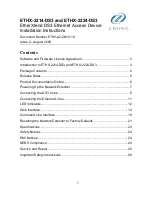
5-2
DuraLAN Fast Ethernet NICs User’s Guide
Notes on NetWare
When you are installing Adaptec DuraLAN NICs, it is a good idea
to document where each port physically resides in the server—
especially when two or more identical NICs exist. This is important
since ports are identified by generic port names, such as Adptsf1,
Adptsf2, Adptsf3, and so on.
Port names are assigned to ports in the order that the system scans
these ports at boot time. Consequently, whenever you physically
rearrange the network cards, the port names change as well.
Online Help
is available from anywhere in NetWare’s menu-
driven dialog boxes during the configuration process. For help, just
press F1 from any area or any window during whatever process
you are currently involved, and Help will appear to assist you.
After you install Duralink64 LAN driver software, use
configsf
to
reconfigure the drivers for Standalone (SA), Failover (FO), Port
Aggregation (PA), or FEC (Fast EtherChannel). (See
Modifying
Driver Configurations on page 5-15
.)
Before You Begin
■
Verify that all system, memory, and NIC requirements are met;
see
System Requirements on page 1-3
.
■
Verify that the new Adaptec DuraLAN NIC(s) have been
installed properly in the server; see
Chapter 2, DuraLAN NIC
Installation
on
page 2-1
.
■
Check your system for installed Adaptec DuraLAN NIC drivers.
If a Duralink64 Standalone driver, Duralink64 Failover driver, or
Duralink64 Port Aggregation driver exists, it must be removed.
For information about driver removal, see
Removing or
Uninstalling Drivers on page 5-15
.
Note:
For Novell NetWare, only one driver type may be
configured at any one time.
















































